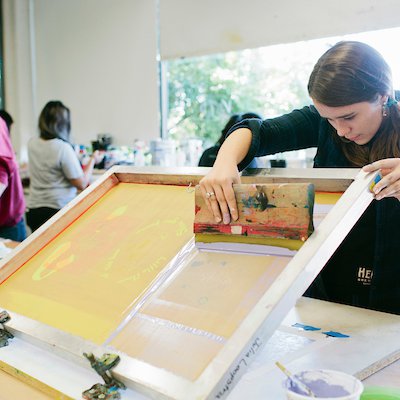The Necessary Overview to Recognizing Screen Printing and Its Versatile Makes use of
Screen printing has a rich background that dates back to old times, developing right into a sophisticated strategy used throughout various markets today. This overview discovers the intricacies of the screen printing process, describing its applications in marketing, fashion, and home décor - 10:9 Design Screen Printing Texas. Recognizing these basics can open creative capacity for both creative and business jobs. The following areas will certainly disclose necessary suggestions and methods to improve one's screen printing endeavors
The History of Screen Printing
Screen printing has origins that map back centuries, its development reflects the technical and imaginative advancements of different cultures. Originating in ancient China, the method was at first used for enhancing fabrics and later spread to Japan, where it ended up being essential to Ukiyo-e woodblock printing. The method shifted to Europe in the 18th century, where it obtained popularity among craftsmens and industrial printers. The invention of picture solution in the 20th century transformed screen printing, allowing for more elaborate styles and better effectiveness. Artists like Andy Warhol even more moved its appeal, using the medium to develop iconic jobs that mixed commercialism and fine art. By the late 20th century, screen printing had actually established itself as a versatile method, employed in fashion, advertising and marketing, and art. Today, it remains to advance, integrating electronic innovation and broadening its applications throughout various industries.
The Screen Printing Process Explained
Screen printing changes artistic visions right into substantial styles with a series of specific actions. Originally, a photo is produced and after that moved onto a screen, commonly constructed from fine mesh fabric extended over a frame. A light-sensitive solution is put on the screen, which is exposed to light, setting in areas not covered by the photo. After cleaning out the unhardened emulsion, a stencil is created.
Next off, the screen is placed over the substratum, whether it be material, paper, or one more product. Ink is then pushed with the open locations of the pattern utilizing a squeegee, transferring the layout onto the substrate below. This process can be repeated for numerous shades, calling for separate displays for each and every hue. The printed thing is healed using warm to assure the ink sticks properly, resulting in a sturdy, vibrant design all set for use.
Kinds Of Screen Printing Techniques

In addition, specialized methods, such as discharge screen printing, eliminate dye from the textile to develop softer prints, while foil screen printing uses metallic foil to attain a shiny surface (10:9 Design LLC Company). Each strategy supplies distinctive features, satisfying numerous innovative demands and production ranges, inevitably article increasing the possibilities within the screen printing domain
Applications of Screen Printing in Various Industries

Additionally, the signage and advertising and marketing markets make use of screen printing for creating attractive displays and banners. This technique allows for bold colors and intricate layouts that capture interest. In electronics, screen printing is used for using conductive inks to motherboard, crucial for element links. Furthermore, the home décor industry welcomes screen printing to create distinct styles on fabrics and wall surface art. In general, screen printing functions as an important tool across varied areas, enhancing items with customized and aesthetically appealing graphics.
Tips for Successful Screen Printing Projects
While embarking on a screen printing task, careful interest to detail can substantially improve the last outcome. Initially, picking premium products is essential; this consists of the screen, inks, and substrates. Utilizing proper mesh counts can influence ink deposition and information resolution. Prep work is similarly vital; complete cleaning of screens and appropriate exposure times ensure crisp prints.
Next, precise registration is vital for multi-color prints. Using positioning tools can help attain exact layering. Furthermore, testing prints on scrap products before manufacturing helps determine prospective concerns without losing resources.

Regularly Asked Concerns
What Products Are Best for Screen Printing on Fabric?
Cotton and polyester blends are suitable for screen printing on textile because of their durability and ink absorption. In addition, specialty materials like silk or canvas can produce one-of-a-kind textures and finishes, improving the general layout quality.
Exactly how Do I Tidy and Maintain Screen Printing Equipment?
To cleanse and preserve screen printing equipment, one should regularly wash displays with ideal solvents, examine squeegees for wear, lubricate relocating components, and shop all products in a completely dry, dust-free setting to extend their life-span.
What Are the Environmental Impacts of Screen Printing?
Screen printing can have significant environmental effects, including chemical waste from inks and solvents, water use throughout cleaning processes, and power usage. Green products and lasting techniques are crucial for lessening these adverse effects.
Can Screen Printing Be Done in the house Effectively?
Screen printing can be properly done at home with have a peek at this site the right materials and strategies. Enthusiasts can develop top quality prints, though success depends on their ability level, equipment, and understanding of the process included.
What Are the Costs Connected With Starting a Display Printing Service?

Starting a screen printing organization entails expenses for equipment, materials, and office. Initial expenses normally vary from a couple of hundred to numerous thousand bucks, relying on the range, top quality of machinery, and desired production capacity.
Screen printing has an abundant history that dates back to old times, progressing into an innovative method utilized throughout different industries today. An additional strategy, rotating screen printing, utilizes round screens, promoting continual printing on fabric rolls, thus improving performance for large manufacturings. Furthermore, specialty techniques, such as discharge screen printing, get rid of dye from the material to develop softer prints, while aluminum foil screen printing applies metal foil to accomplish a glossy finish. In the fashion market, screen printing is extensively used to create vibrant layouts on apparel, allowing brands to showcase their unique styles. Cotton and polyester blends are suitable for screen printing on textile due to their sturdiness and ink absorption.